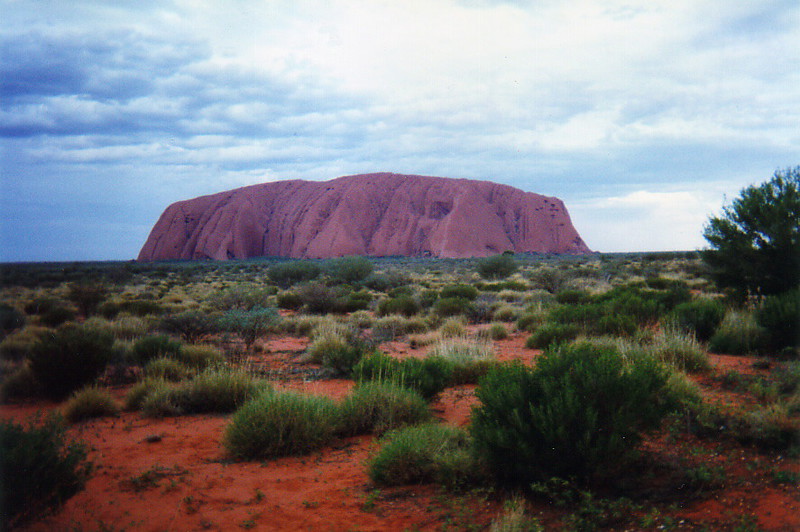
On Monday my itchy feet got me rolling to the Rock. Ayers Rock, or Uluru to give it its proper title, is part of the Uluru-Kata Tjuta National Park, so called because it contains Uluru and Kata Tjuta, the latter being more commonly called the Olgas. I'd approached this final blast on my journey with some trepidation, mainly because of what I'd heard from fellow travellers. Comments such as 'It's incredibly expensive' and 'It's just a big rock' didn't paint the prettiest picture, and after Kakadu, I wasn't going to let myself get all excited only to come away disappointed.
Fear not. Uluru-Kata Tjuta is a complete delight, and I really can't understand people's complaints. The only accommodation is outside the park at Yulara, about 20km from Uluru, and although I've met loads of people who've complained that it's prohibitively expensive and aimed at rich tourists, I found A$9 per night at the beautifully manicured camp ground to be a good deal cheaper than a lot of other places I've stayed, and the showers were the most powerful I've seen for a long time (an important point in the dusty heat of the desert). I think some people moan because they charge A$9 per person rather than per site, so if there's four of you crammed into one car, it's A$36 per night, a fairly high charge; then again, I've often had to pay site rates for two, regardless of the fact that I'm alone, so what comes around goes around, and I can sympathise with charging per head when resources like water are so expensive.
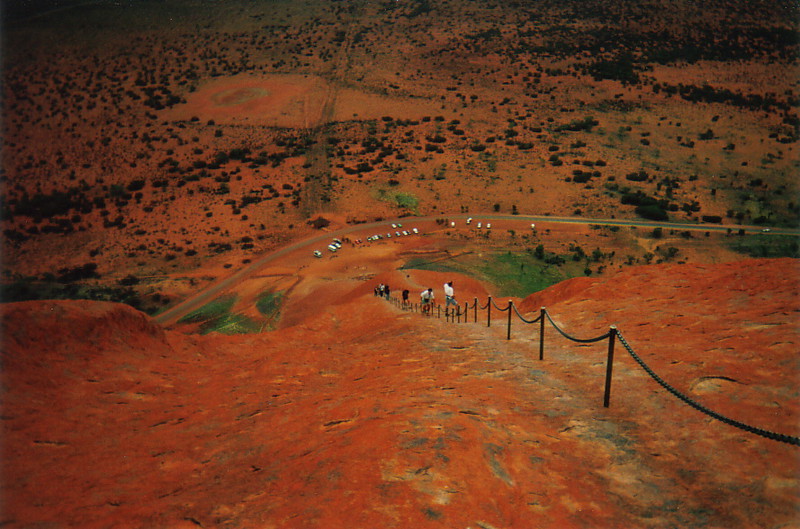
When I arrived after the morning drive from Watarrka, I booked in, set up camp in a lovely shady bay on the most luscious grass you've ever seen (particularly given that this is the middle of a desert), and headed out to explore Uluru. As I'd booked in for three nights I wasn't in a rush – back in Trephina Gorge, Annette had recommended that I really soak up the atmosphere if I wanted to get into the spirit of the place – so I popped into the Cultural Centre on the way to the Rock. As with the one in Kakadu it was excellent, with plenty of information about the dreaming stories of the area, and displays about everything from bush tucker to religious ceremonies to Aboriginal history, and it began to make me realise that Uluru isn't just a rock sticking out of the scrub, it's something culturally significant and utterly unique. This was a view shared by Graham and Helen, the couple from Gove whom I'd met at King's Canyon and whom I bumped into again at the Cultural Centre, reminding me just how small the tourist trail is in the Red Centre. I was starting to get excited.
Exploring Uluru
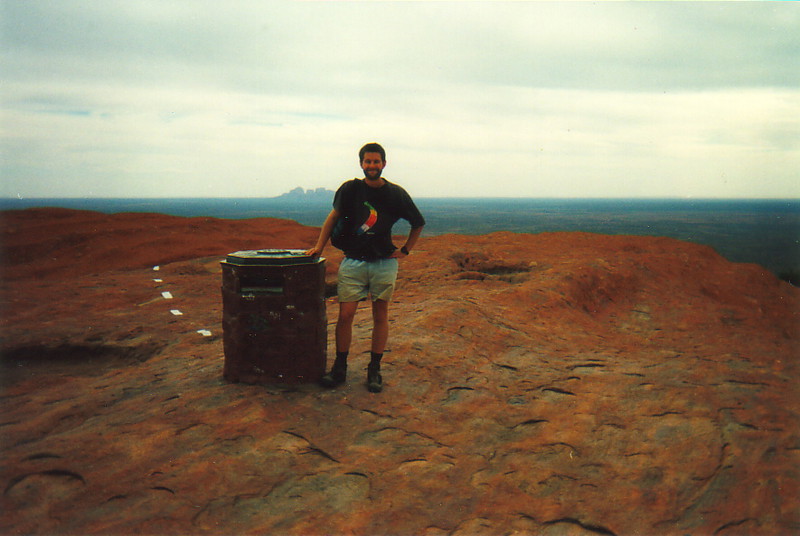
Champing at the bit, I drove off to Uluru itself. It's pretty difficult to explain just how impressive it is – you have to see it yourself to understand – but everyone has seen pictures of it, so try to imagine a towering monolith that's 348m above the ground at its highest point, and you start to get the picture. Although it's against Aboriginal wishes – the park is owned by the Aborigines now, after some serious legal wrangling in the 1970s and 1980s – you can climb the Rock, so climb it I did.
Wow, it was scary. It's a hell of a long climb, with a very steep start where you haul yourself up on a chain for what seems like miles, and then the chain stops and the fun really starts. When I climbed it, the wind was howling and I was seriously scared to go beyond the end of the chain for fear of being blown off (and I'm being serious – it really was petrifying!). But I persevered and eventually reached the top, after following a dotted line that wound around through the desolate moonscape on the summit. The views were good, but not spectacular – there's not a lot to see in a flat desert, really – so after a quick scout around the top I climbed back down, where I was really relieved to be on the ground, with chapped lips, aching ears and – ahhh! – no wind. I could understand how a number of people have died on the climb from heart attacks or falling off, and there are five in memoriam plaques attached to the rock at the bottom of the climb. The climb is worth doing, but certainly only once.
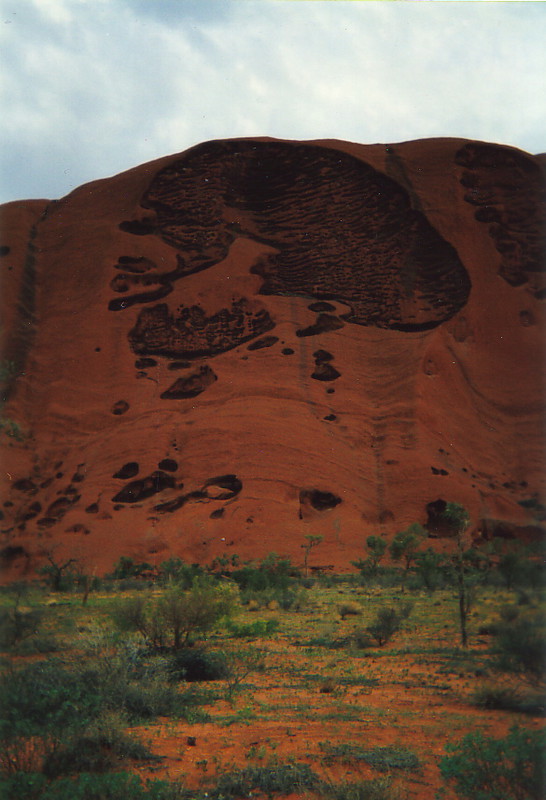
However the walk round the base of Uluru is quite stunning, and is well worth repeating. Happily most tourists are too rushed to do this 9km wander round the Rock – they want to climb it, photograph it, watch the sunset change its colours, and then go back to their air-conditioned coaches and hotel rooms – but it's so awesome that I'd rate it much higher than the climb. The pictures one sees of Uluru are all from the same angle, because commercial photography is banned from the other angles, and walking round it really gives you an appreciation of Uluru's weird and wonderful shapes and textures. There are numerous points of interest along the track, from sacred rock pools to rock art to amazing wind erosion patterns, and you come across certain areas that are very significant to the Aborigines which you can't enter or photograph. Aborigines believe that photography steals part of the spirit from people, which is why you won't find any pictures of indigenous people in my collection, unless they're there by accident; with sacred sites they also believe that these areas are too important to have their relationship with the surrounding area ignored by isolating the site in a photograph, which is one of the reasons for the constraints on commercial photography.
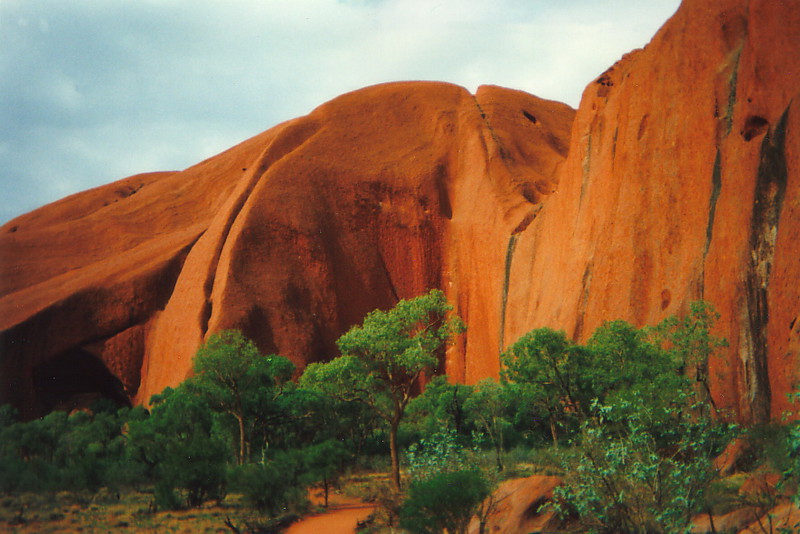
I was really moved by the walk. It's such a powerful place, and I totally fell in love. One incident summed up the big difference between my experience and that of others; as I was walking up to one of the rock art sites, this middle-aged woman turned to her husband and said, 'Well, it does nothing for me. A child could do better. This isn't art, it's a mess.' And she turned on her heel, flicked her overdone hair and waltzed off. What a fool she was: if she'd bothered to read anything about rock art, she would have known it isn't aesthetic, it's functional; it's not beautiful, it's ceremonial. The Aborigines painted pictures because they never wrote anything down; Aboriginal language has only just started to be written down in an attempt to preserve cultural stories. It isn't supposed to look good, in the same way that a book isn't supposed to taste great and music isn't supposed to smell terrific. How can people spend thousands of dollars on luxury tours and trips to such important sites without even spending a couple of minutes reading up about the place? They came, they climbed, they photographed and they left empty Coke cans behind. What a shame...
That night I went to see the sunset over Uluru, though the cloud covering made it less spectacular than it can be, and on my way back to the tent I bumped into two wonderful old ladies whom I'd met at Ormiston Gorge. They echoed my sentiments; they'd arrived with niggling doubts about whether it would be worth it, but they were as impressed as I was. I felt quite elated that my last real tourist spot in Australia was turning out to be one of the best.
Exploring Kata Tjuta
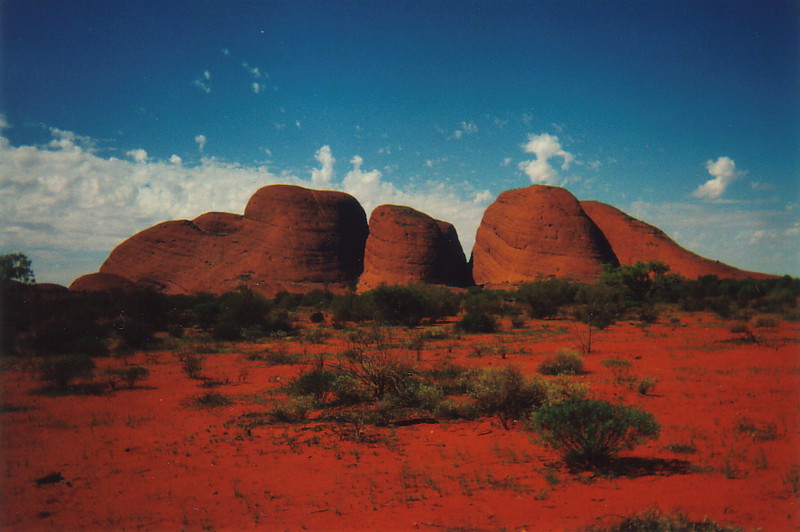
The next day I set off to explore Kata Tjuta (or the Olgas as Europeans call them). This collection of beautifully shaped mounds and hills is like a very eroded Uluru, with winding gorges and a couple of lovely walking tracks that pick their way through the same red rock as Uluru, all twisted into these amazing shapes. Kata Tjuta means 'many heads' in the local Aboriginal dialect, and it's a good name; it's easy to see why a lot of people prefer it to Uluru itself.
I'd driven off to see the sunrise on Uluru early in the morning, but the clouds put pay to that idea, so I drove straight on to the Kata Tjuta lookout, arriving there before the tourist masses (though I did bump into a couple whom I'd chatted to in Trephina Gorge – meeting people from the tourist trail is obviously becoming something of a habit).
The walks at Kata Tjuta are delightful; I set off on the longer of the two, which passes in a loop through the Valley of the Winds, and I figured it was a good thing I was on disposable cameras, as otherwise I would have taken far too many pictures – this place is truly amazing. I bumped into Graham and Helen again, and we joined up for the (supposedly) three-hour hike through the range, nattering away through the scenery; sometimes it's great to walk with people, and sometimes it's not, but for this walk it was very welcome, and to cap it all, we bumped into the couple from Trephina at the end of the walk, and all five of us started yarning away; whoever thought you're lonely when you're alone has obviously never visited the Red Centre.
Watching Kata Tjuta
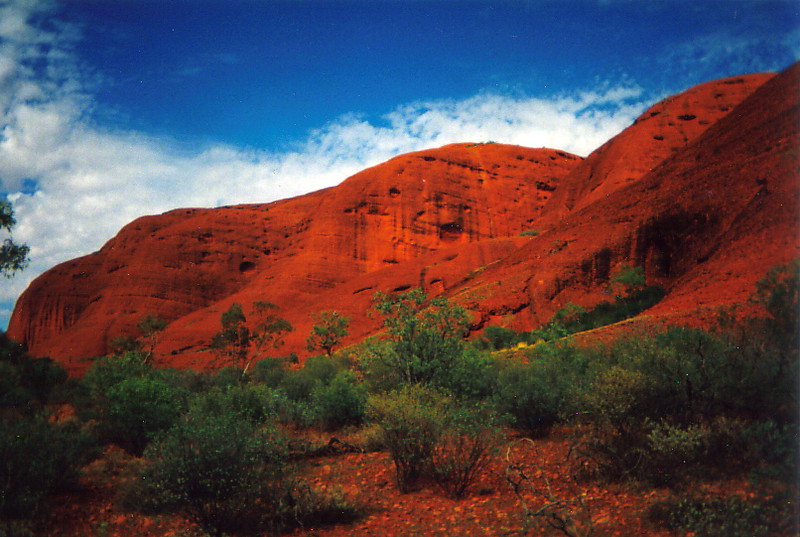
By now I'd explored all the walks and thoroughly enjoyed them, so it was time to take the advice of Annette, the painter I'd met in the Eastern Macdonnell Ranges, and just sit around watching for the next day and a half. So the following morning I drove off to the sunset-viewing site for Kata Tjuta, had lunch, settled down in the shade and started to write, all in full view of the spectacular curves of Mt Olga. And Annette was right: if you settle down, relax and just take in the atmosphere, that's when you really begin to understand. If I'd been living here before the white man came, I'd have made up stories about the place too.
I spent the whole afternoon at Kata Tjuta, reading about and getting all excited about visiting New Zealand, and at about tea time, who should walk into my secluded little picnic area but yet another couple I'd met briefly at Trephina Gorge (they had been about to leave the gorge as I'd arrived). We got talking, and Craig and Sue, as they introduced themselves, brewed up cups of coffee that we supped while waiting for the sunset. They'd been travelling for seven months on long-service leave, and when they got back home to Tassie they were planning to sell up, buy a bigger caravan and travel for good, picking up work en route. I envied them something rotten; I hope I get to do something similar when I'm their age.
So imagine my amazement when, on this day of bumping into people by coincidence, they revealed that they'd camped next to Ted, Gill and their passengers (whom I'd met in Litchfield) at the Devil's Marbles; unfortunately Ted and Gill had been having a bit of a traumatic day, with a blown tyre and a problem with their cooker's gas bottle. The reason we discovered this further connection? Because I'd mentioned that I'd had my sleeping bag stolen from Shady Glen, and Craig and Sue said they'd heard about the theft from quite a few people and that the story was doing the rounds of the travelling community, and that one of the couples who had warned them about Shady Glen was Ted and Gill. Craig and Sue even knew who I meant when I said I had camped next to a mad German in Ormiston, who kept muttering to himself and packing and unpacking his red 4WD. It really is a terribly small world in the huge expanse of the outback...
Sunset Storm
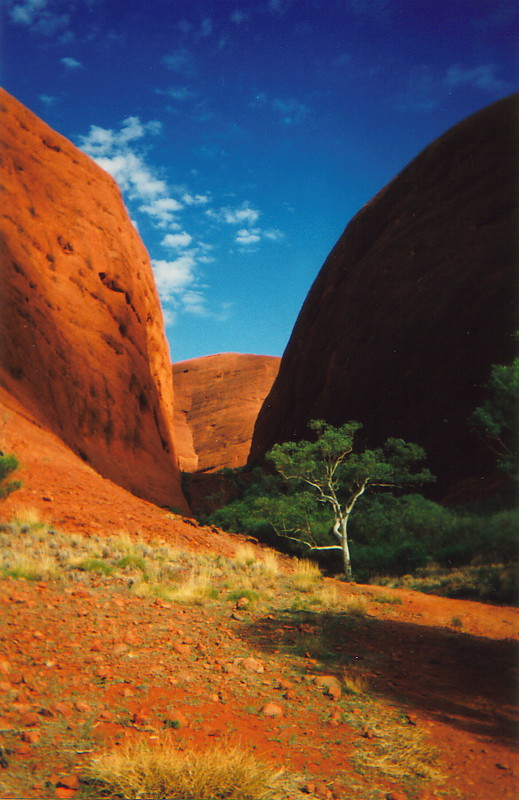
The sunset over Kata Tjuta was beautiful, though cut short by low clouds on the horizon, and before long I'd started the 50km drive back to Yulara. On the far eastern horizon there were some serious clouds lurking, and as I drove towards them they started to flash with electrical activity, even though the skies above me were as clear as a bell. As I continued driving, the sight took on a strangely mystical air; on my right-hand side a nearly full moon was lighting up Uluru, while on my left was the reddish-purple glow of the sunset, and straight ahead the sky flashed with tremendous force. It must rate as one of the most incredible sights I've ever seen; I'm not ashamed to say I was nearly moved to tears.
When I got back to camp I got my washing in and shot up to the lookout, where I sat and watched the heavens rip themselves apart, while not a drop fell on Yulara. At the lookout I struck up a conversation with a very pleasant couple from Geelong who were really enjoying the park and were gutted they had to leave in the morning, but before long I had to eat, so I wandered down to the kitchen and cooked my usual rice-type dish on the free barbies there. It was there that I started chatting with a couple of Poms who had driven down from Darwin, and then it hit me: throughout the day I'd been meeting older Aussie travellers who were all full of life, thrilled by the area, and really interesting to talk to. But these two seemed so unhappy, even though they said they were enjoying themselves; they looked dour, never smiled or laughed, and conversation was a serious effort on my part (so eventually I just gave up). This is happening more and more with my fellow countrymen; I try and try but so often they're just so bloody miserable. Combine this with the English character trait of an inferiority complex mixed, paradoxically, with a superiority complex, and you have the quintessential whinging Pom; I often find myself thinking not so much 'Will I cope when I return?' as much as 'Will I bother to cope when I return?' I just hope my continued disillusionment with the place I still regard as home is simply a symptom of the stunning journey I am having; I'd hate to fall out of love with my home country, as so many ex-pats do.
Oh, and just for the record, when I settled down with my lamp and a book, I noticed that the guy camped next to me had also camped next to me in Alice Springs. By this stage, I wasn't even surprised, and just went back to reading about my next destination.
Watching Uluru
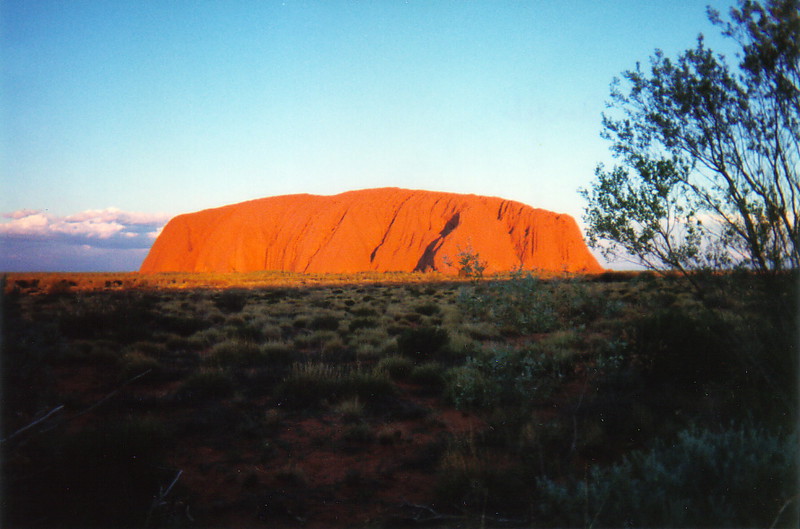
The following day I decided to give Uluru the same treatment as I'd afforded Mt Olga; Annette's advice was so good that I couldn't just save it for Kata Tjuta. The night before, the storm I'd been watching had passed overhead, bringing serious lightning and massive thunderclaps but mercifully little rain, so I got up really early on Wednesday morning to catch the sunrise over Uluru. The skies had totally cleared, and I parked and walked some distance from the crowded sunrise-viewing area, to avoid all the amateur Spielbergs who were clogging up the view1. Sunrise over Uluru is an amazing sight, and it's pretty pointless trying to capture its immensity on film, so I just settled back and watched the rock change from black to purple to deep red to lighter and lighter shades as the sun broke the horizon. It was a cold but beautiful experience.
I spent the rest of the day in peace at Uluru. I popped into the Cultural Centre to buy a leaflet that explains the base walk round Uluru, telling all the Aboriginal Dreaming stories relating to interesting spots; the two old ladies had showed me their copy, and for A$1 it makes a lovely memento of the area. It explains how the Anangu (the Aboriginal tribe that lives in the area) live their lives by the religious heritage of Tjukurpa (the generic term for which is Dreaming), and how Uluru is a living reminder of Anangu Tjukurpa. The leaflet went on to say that when you see Uluru, you might begin to understand just how powerful this place is; I completely concur.
On the way I passed the climbing chain, and I couldn't believe how packed it was; I just had to take a photo of the line of silhouettes going all the way up the Rock. It made me realise how lucky I was, because when I did the climb, I only saw three other people between the end of the chain and the cairn – the wind had probably put the others off. It must be impossible to appreciate the barren and surreal nature of the top of the Rock when it's full of babbling tourists, and you can bet none of them had bothered to buy a booklet on the Anangu Tjukurpa. It's easy to see why the Anangu call the tourists minga ('ants') when they climb.
Luckily even the busloads of tourists can't destroy the powerful atmosphere of Uluru. It's really something else.
1 You have never seen so many video cameras in your life. It seems that people film entire sunrises and sunsets, but do they actually watch them at home? A good point was made by a fellow traveller I met in WA, who said, 'I'm sure some of these people have to go home and watch their videos to know what they've seen.' I can see his point; it's a shame to think that lots of people's view of the Uluru sunrise is as a small black-and-white TV image in the eyepiece of a video camera.
Indeed, I sometimes wish I didn't have a camera (though, of course, the desire to record what I see outweighs the inconvenience). If you have no camera, then you don't get obsessed with getting the right shot, capturing the moment or having enough film, and you don't get annoyed if you miss that amazing shot of a croc or a sunrise. You just look, and I sometimes really wish I could be like that, though I know I'd regret it later if I had no photos on my return. Perhaps people in glass houses shouldn't throw stones, though I'm still not convinced by videos of sunsets...